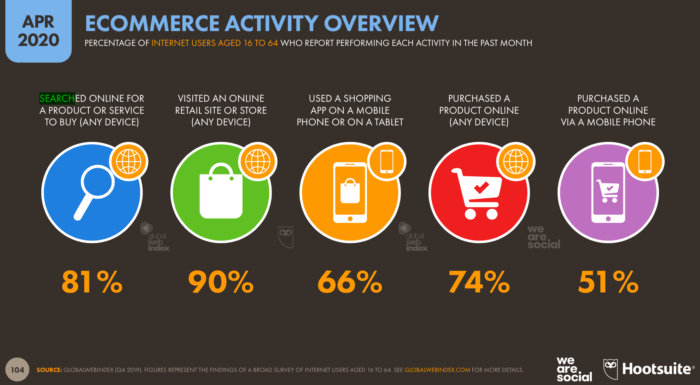
Statistics on search engine marketing usage and adoption to inform your search engine marketing strategies and tactics
Statistics help us turn data into information, allowing us to make informed and rational decisions and that’s exactly the purpose of this article. We’re huge fans of search engine marketing, but not everyone believes in its potential for growing a business, either through search engine optimization or paid search marketing – which means a Google Ads focus in many countries.
This article is aimed at helping you make better-informed decisions about the running of your search marketing and making the business case by modelling the returns from search engine marketing if you’re using a search gap analysis to put a quantitative estimate to the returns. We’ll start by reviewing how many people search, then look at the top search engines and finish with the growing popularity of voice search.
How many searches are made each day?
The importance of search in influencing product purchase is suggested by this data from Global Web Index via Datareportal. This shows that
“81% of people search online for a product or service“

74% have purchased online via any device and 66% use mobile apps.
Who has the biggest search engine market share worldwide?
Google continues to dominate search engine use, starting 2020 with an average net market share of 73.34% on desktop according to NetMarket Share. However, this figure is actually slightly below where it stood at the start of 2019 (75.46%) as Bing’s net share has seen a slight increase.

Even with the small dip to start the year, Google is still the market leader, which needs to be taken into account for your digital strategy. This isn’t to say that you should discount other search engines though, especially a Bing and Baidu have more than a 10% market share each.

It’s also worth pointing out that since Google reached a net market share high of 78.23% in January 2019, it has seen a decline, with Bing and Baidu seeing small increases throughout this time.
While it’s not possible to say exactly what has caused this, trust in Google has been impacted over the last year, which could be seeing people look to alternative search engines.

It’s a slightly different story on mobile, however, as Google saw a big drop in August 2018 but has since seen net market share increase, meaning it started 2020 off with 92.81%. This is likely due to Google’s continued focus on the importance of mobile UX factors for SEO.
Desktop vs mobile vs tablet searches
Up until mid-2019, mobile and desktop searches were mostly neck and neck, with mobile just edging into the lead every few months. However, June 2019 saw mobile account for 50.71% of searches, with desktop dropping down to 45.53%.
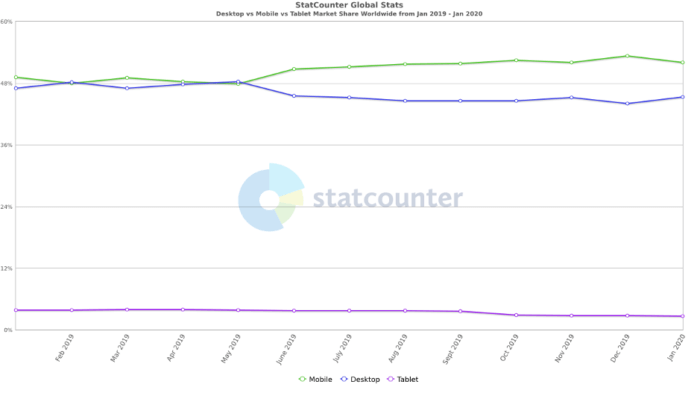
Since this point, the gap between mobile and desktop searches has remained, with mobile becoming the top option for searchers. This shows that as more people remained connected 24/7 due to the high mobile phone penetration across the globe, desktop searches are likely to continue to decline.
In terms of the share of searches handled by tablets, these have seen a decline since the start of 2019. Although tablet’s share stayed consistently around 3.5% up to September 2019, October saw it drop to 2.93% and then decline further each month.
It is likely that mobile searches are only going to increase throughout 2020 as it becomes the dominant technology choice in terms of accessing the internet. Tablets are likely to continue to decline in use as people opt for more high-tech smartphones instead of multiple devices.
The impact of mobile search on SEO
What does this change in search habits mean for SERPs? At the moment, only 13% of websites are able to retain the same position for a particular search across all devices. So, you may be ranking well on desktop but not even appear on the first page of results on mobile. In fact, 30% of pages that show on the first page of desktop search results do not appear in the top 10 results on mobile.
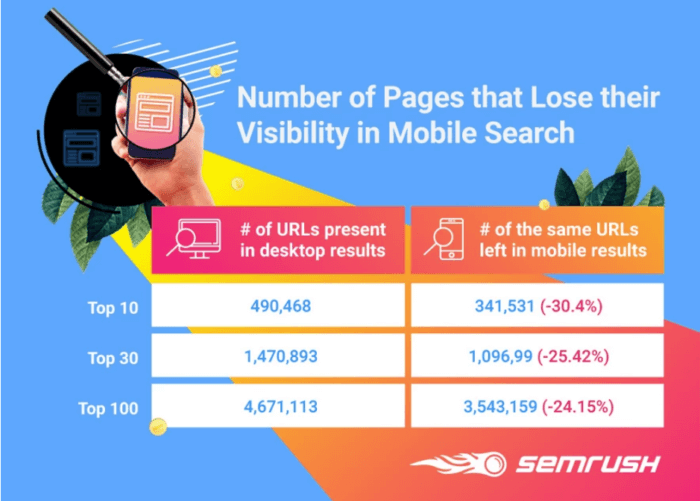
According to SEMRush, 71.76% of domains change rankings by one place on mobile compared to desktop, 52.16% change by three places and 29.16% change by 10 places. Although moving down one place may not seem like too big a deal, mobile searchers have different habits to those on desktop and so not being in the top three results could have a serious effect on your mobile traffic.
This is why sites in 2020 need to ensure that they are as mobile-optimized as possible and that they keep an eye on mobile rankings rather than simply keeping tracking of desktop rankings.
How much trackable web traffic comes from organic vs paid search?
The combination of organic and paid search is powerful, with 68% of all trackable website traffic coming from a combination of the two tactics. This means that they are both more beneficial for websites than other traffics like display and social media.
However, when looking at them separately, organic SEO is the dominant source of trackable web traffic, with 53% of traffic coming via this channel compared to paid’s 27%.
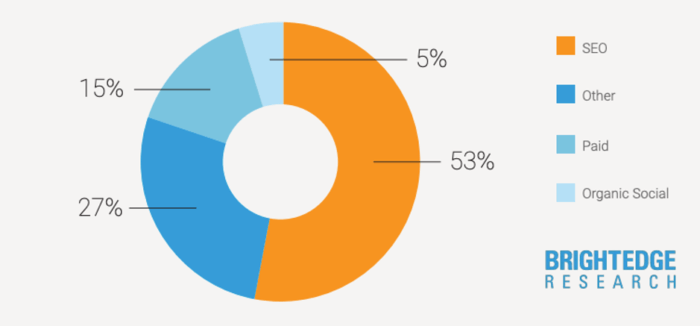
Organic search’s dominance is fairly impressive considering the changes that have been made to the layout of search engine results pages (SERPs), which have pushed organic results further down the page, giving more dominant positions to paid results. However, users seem to put more trust in the results that rank highly organically.
How many clicks do organic search results generate?
While we already know that the place to be in search results is on the first page, however, it looks as though you really want to be result one to five.
The first five organic results of a search – when looking at the first page of results only – account for around 67.60% of all the clicks for a search query. In comparison, results six to ten on the first page only account for 3.73% of clicks.
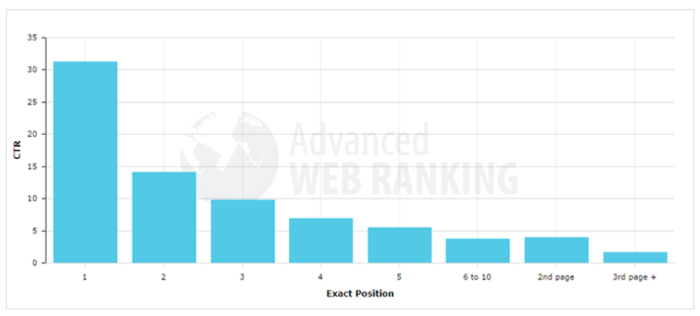
The first page of results also accounts for around 71.33% of organic clicks, with page two and three getting just 5.59%, showing that failing to rank highly will seriously damage your traffic. It also seems as though people prefer to click on organic results rather than adverts, with just 15% of all traffic either clicking on PPC ads or trying a new search.
How many Google searches result in a click?
Ranking highly on the first page or organic results doesn’t guarantee a click, though. Zero-click searches on Google have seen a steady increase over the last three years, with 48.96% of all US Google searches in the first quarter of 2019 ending without a click. This is a 12% rise from Q1 of 2016.
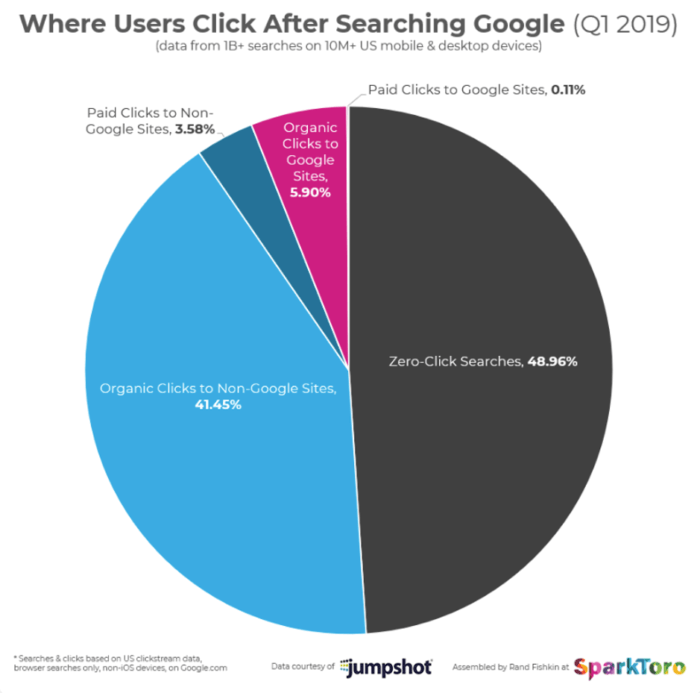
While this suggests that almost half of searches were solved without the need for a click, it does mean that organic traffic to websites as a whole is seeing a drop.
The answer to this doesn’t appear to be PPC either, as just 7.2% of searches clicked through to a paid result. In fact, for every click to a paid result, there are 11.6 clicks to organic results, showing that a focus on SEO and click-through optimization is key.
Voice search popularity
The increased use of smartphones and smartspeakers has greatly increased the potential for voice searches and means we now have to think about the relevance of SEO for voice. This is now a common behaviour as the latest data from Global Web Index via Datareportal shows, with an average of 45% using voice commands or voice search (unfortunately the research does not isolate voice search only).

Voice searching behaviour is higher in younger age groups, but only declines markedly in the 55+ age group.


